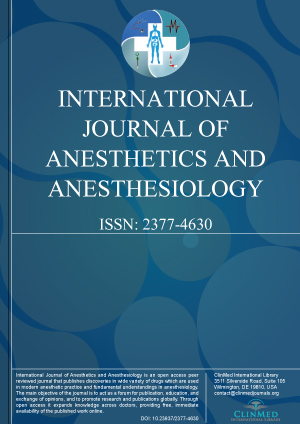Open Access DOI:10.23937/2377-4630/3/2/1048
Ultrasound-guided Transmuscular Quadratus Lumborum (TQL) Block for Pain Management after Caesarean Section
Nina Maenchen, Christian Kruse Hansen, Mette Dam and Jens Borglum
Article Type: Case Report | First Published: June 28, 2016
The ultrasound-guided transmuscular quadratus lumborum (TQL) block performed in the lumbar paravertebral region exerts its effect by spreading into the thoracic paravertebral space with blockade of both somatosensory and visceral nerves of the abdominal and retroperitoneal region. We discovered an inadequate management of post-operative pain by the conventional analgesic regimen among caesarean section patients in our hospital. In this report we present three cases where the TQL block is demonst...
Open Access DOI:10.23937/2377-4630/3/2/1047
Comparison of the Analgesic Effects of Preemptive Lornoxicam and Paracetamol after Laparoscopic Cholecystectomy
Tugba Karaman, Tamer Kuzucuoglu, Gulten Arslan, Serkan Karaman and Mujge Hatun
Article Type: Original Article | First Published: June 13, 2016
Despite increasing knowledge about pain, postoperative pain management is still a challenge. Opioids are widely used drugs in the treatment, but the side effects of the opioids lead to investigations about the novel pain management strategies. We aimed to compare the effects of preemptive intravenous lornoxicam and paracetamol on postoperative pain scores, opioid consumption, and patient satisfaction during laparoscopic cholecystectomy recovery....
Open Access DOI:10.23937/2377-4630/3/2/1046
A Retrospective Review of Corneal Abrasions after Oncologic Surgery in a Tertiary Cancer Center
SJ Gandhi, A Zavala, U Williams, A Van Meter, P Hsu, DS Gombos and P Owusu-Agyemang
Article Type: Research Article | First Published: May 07, 2016
Corneal abrasions are the single most common ocular injury in the perioperative period. The exact etiology of perioperative corneal abrasions is usually unclear, and several risk factors have been described. The aim of our study was to determine the incidence of known and hypothetical risk factors for corneal abrasion in a cohort of cancer patients who had developed corneal abrasion after oncologic surgery. Our review showed a high incidence of risk factors which were similar to that reported fo...
Open Access DOI:10.23937/2377-4630/3/2/1045
Feasibility and Timing of Craniosynostosis Surgery in a Child with Hypoplastic Left Heart Syndrome
C Hochhold, P Paal, G Luckner, M Rasse and C Velik-Salchner
Article Type: Case Report | First Published: April 11, 2016
Nowadays, children with hypoplastic left heart syndrome (HLHS) survive longer. Thus, the management of such patients undergoing non-cardiac surgery is of increasing relevance. A 12-month-old boy with HLHS following stage II Norwood palliation and Apert syndrome required extended craniosynostosis surgery because of elevated intracerebral pressure. Since extensive blood loss as well as hemodynamic instability were expected, anesthetic and surgical management were carefully planned in a multidiscip...

